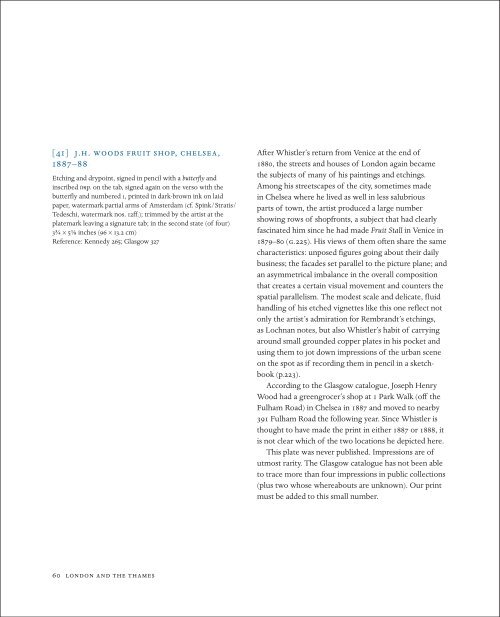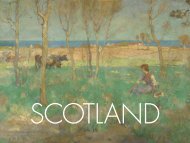Create successful ePaper yourself
Turn your PDF publications into a flip-book with our unique Google optimized e-Paper software.
[41] J.H. Woods Fruit Shop, Chelsea,<br />
1887–88<br />
Etching and drypoint, signed in pencil with a butterfly and<br />
inscribed imp. on the tab, signed again on the verso with the<br />
butterfly and numbered 1, printed in dark-brown ink on laid<br />
paper, watermark partial arms of Amsterdam (cf. Spink/Stratis/<br />
Tedeschi, watermark nos. 12ff.); trimmed by the artist at the<br />
platemark leaving a signature tab; in the second state (of four)<br />
3 3/4 x 5 1/8 inches (96 x 13.2 cm)<br />
Reference: Kennedy 265; Glasgow 327<br />
After Whistler’s return from Venice at the end of<br />
1880, the streets and houses of London again became<br />
the subjects of many of his paintings and etchings.<br />
Among his streetscapes of the city, sometimes made<br />
in Chelsea where he lived as well in less salubrious<br />
parts of town, the artist produced a large number<br />
showing rows of shopfronts, a subject that had clearly<br />
fascinated him since he had made Fruit Stall in Venice in<br />
1879–80 (g.225). His views of them often share the same<br />
characteristics: unposed figures going about their daily<br />
business; the facades set parallel to the picture plane; and<br />
an asymmetrical imbalance in the overall composition<br />
that creates a certain visual movement and counters the<br />
spatial parallelism. The modest scale and delicate, fluid<br />
handling of his etched vignettes like this one reflect not<br />
only the artist’s admiration for Rembrandt’s etchings,<br />
as Lochnan notes, but also Whistler’s habit of carrying<br />
around small grounded copper plates in his pocket and<br />
using them to jot down impressions of the urban scene<br />
on the spot as if recording them in pencil in a sketchbook<br />
(p.223).<br />
According to the Glasgow catalogue, Joseph Henry<br />
Wood had a greengrocer’s shop at 1 Park Walk (off the<br />
Fulham Road) in Chelsea in 1887 and moved to nearby<br />
391 Fulham Road the following year. Since Whistler is<br />
thought to have made the print in either 1887 or 1888, it<br />
is not clear which of the two locations he depicted here.<br />
This plate was never published. Impressions are of<br />
utmost rarity. The Glasgow catalogue has not been able<br />
to trace more than four impressions in public collections<br />
(plus two whose whereabouts are unknown). Our print<br />
must be added to this small number.<br />
60 london and the thames



